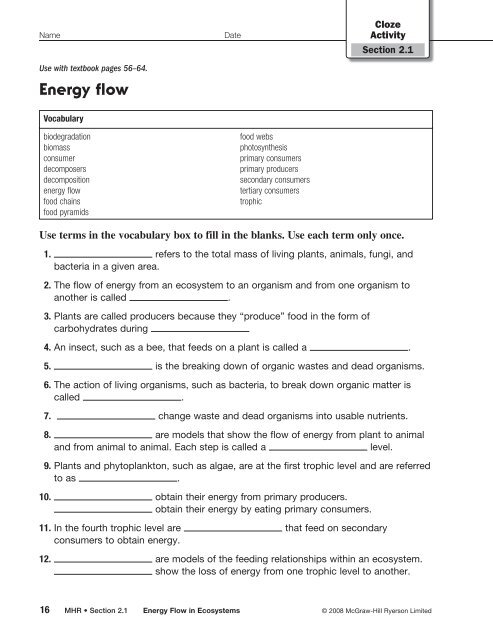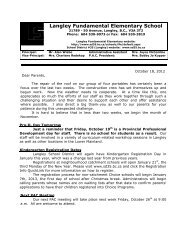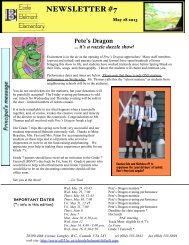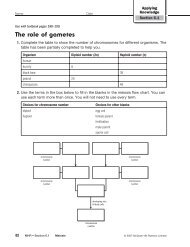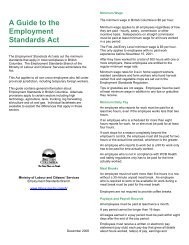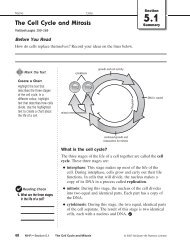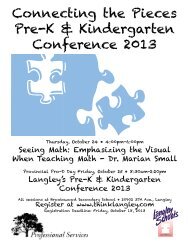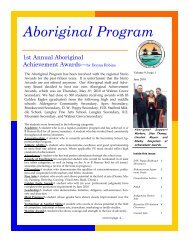BC10WB2-1
BC10WB2-1
BC10WB2-1
You also want an ePaper? Increase the reach of your titles
YUMPU automatically turns print PDFs into web optimized ePapers that Google loves.
Name<br />
Use with textbook pages 56–64.<br />
Energy flow<br />
Date<br />
Cloze<br />
Activity<br />
Section 2.1<br />
Vocabulary<br />
biodegradation<br />
biomass<br />
consumer<br />
decomposers<br />
decomposition<br />
energy flow<br />
food chains<br />
food pyramids<br />
food webs<br />
photosynthesis<br />
primary consumers<br />
primary producers<br />
secondary consumers<br />
tertiary consumers<br />
trophic<br />
Use terms in the vocabulary box to fill in the blanks. Use each term only once.<br />
1. refers to the total mass of living plants, animals, fungi, and<br />
bacteria in a given area.<br />
2. The flow of energy from an ecosystem to an organism and from one organism to<br />
another is called .<br />
3. Plants are called producers because they “produce” food in the form of<br />
carbohydrates during<br />
4. An insect, such as a bee, that feeds on a plant is called a .<br />
5. is the breaking down of organic wastes and dead organisms.<br />
6. The action of living organisms, such as bacteria, to break down organic matter is<br />
called .<br />
7. change waste and dead organisms into usable nutrients.<br />
8. are models that show the flow of energy from plant to animal<br />
and from animal to animal. Each step is called a<br />
level.<br />
9. Plants and phytoplankton, such as algae, are at the first trophic level and are referred<br />
to as .<br />
10. obtain their energy from primary producers.<br />
obtain their energy by eating primary consumers.<br />
11. In the fourth trophic level are that feed on secondary<br />
consumers to obtain energy.<br />
12. are models of the feeding relationships within an ecosystem.<br />
show the loss of energy from one trophic level to another.<br />
16 MHR • Section 2.1 Energy Flow in Ecosystems © 2008 McGraw-Hill Ryerson Limited
Name<br />
Date<br />
Interpreting<br />
Illustrations<br />
Section 2.1<br />
Use with textbook pages 60–64.<br />
Food chains, food webs, and food pyramids<br />
Use the diagrams to help you answer the questions.<br />
Scientific model<br />
food chain<br />
Questions<br />
1. What plants or animals are the primary producers in<br />
this food chain?<br />
red-tailed hawk<br />
sea otter<br />
2. What trophic level do the frogs and crabs belong to?<br />
spotted frog<br />
crab<br />
3. What do tertiary consumers feed on to obtain energy?<br />
grasshoper<br />
krill<br />
bunchgrass<br />
algae<br />
Terrestrial food chain<br />
Aquatic food chain<br />
food web<br />
grizzly bear<br />
red-tailed<br />
hawk<br />
4. What term is used to describe a chipmunk that eats<br />
seeds or fruit?<br />
5. What kind of consumers do omnivores eat?<br />
deer<br />
grouse<br />
chipmunk<br />
marmot<br />
6. Give two examples of detrivores.<br />
decomposers<br />
and detrivores<br />
berries and flowers<br />
grasses<br />
seeds<br />
© 2008 McGraw-Hill Ryerson Limited Section 2.1 Energy Flow in Ecosystems • MHR 17
Name<br />
Date<br />
Interpreting<br />
Illustration<br />
Section 2.1<br />
continued<br />
food pyramid<br />
7. What is a food pyramid?<br />
great horned<br />
owl<br />
long-tailed<br />
weasel<br />
8. Which level of a food pyramid stores the most<br />
energy?<br />
jackrabbit<br />
9. Which level of a food pyramid stores the least amount<br />
of energy?<br />
grasses<br />
Food pyramid<br />
18 MHR • Section 2.1 Energy Flow in Ecosystems © 2008 McGraw-Hill Ryerson Limited
Name<br />
Date<br />
Illustrating<br />
Concepts<br />
Section 2.1<br />
Use with textbook pages 58–64<br />
Modelling a local ecosystem<br />
Reflect on the plants and animals that exist in your local ecosystem.<br />
1. List 12 plants and animals. Remember to represent each of the trophic levels.<br />
2. Organize four of these plants and animals into a food chain.<br />
3. Using all 12 of the plants and animals, design a food web that illustrates the feeding<br />
relationships within your selected ecosystem.<br />
4. Organize the plants and animals into a food pyramid that demonstrates the loss of<br />
energy as you move from one trophic level to the next.<br />
© 2008 McGraw-Hill Ryerson Limited Section 2.1 Energy Flow in Ecosystems • MHR 19
Name<br />
Date<br />
Assessment<br />
Section 2.1<br />
Use with textbook pages 56–64.<br />
Energy flow in<br />
ecosystems<br />
Match each Term on the left with the best<br />
Descriptor on the right. Each Descriptor may only<br />
be used once.<br />
Term<br />
Descriptor<br />
1. biodegradation<br />
2. consumers<br />
3. decomposers<br />
4. food chain<br />
5. food pyramid<br />
6. food web<br />
7. producers<br />
8. trophic levels<br />
A. a model that shows<br />
the flow of energy from<br />
plant to animal and<br />
from animal to animal<br />
B. organisms that produce<br />
food in the form<br />
of carbohydrates during<br />
photosynthesis<br />
C. the breaking down of<br />
dead organic matter<br />
by organisms, such as<br />
bacteria<br />
D. steps in a food chain<br />
that show feeding and<br />
niche relationships<br />
among organisms<br />
E. a model that shows the<br />
loss of energy from one<br />
trophic level to another<br />
F. an organism that eats<br />
other organisms<br />
G. a model of the feeding<br />
relationships within an<br />
ecosystem<br />
H. organisms that break<br />
down wastes and dead<br />
organisms and change<br />
them into usable nutrients<br />
Circle the letter of the best answer.<br />
9. In a food chain, primary producers are<br />
usually:<br />
A. amphibians C. mammals<br />
B. bacteria D. plants<br />
10. What product of photosynthesis supplies<br />
energy for life forms?<br />
A. carbohydrates<br />
B. carbon dioxide<br />
C. oxygen<br />
D. water<br />
11. Which of the following organisms are<br />
likely to be found in the third trophic level<br />
of a food chain?<br />
A. algae C. grasshopper<br />
B. frog D. hawk<br />
12. Which of the following describes the<br />
process of biodegradation?<br />
A. plants using photosynthesis to create<br />
food<br />
B. primary consumers eating plants<br />
C. bacteria breaking down organic matter<br />
D. omnivores eating plants and animals<br />
13. In a food pyramid, how much energy is lost<br />
from trophic level to trophic level?<br />
A. 20 % C. 70%<br />
B. 50 % D. 90%<br />
14. In a food pyramid:<br />
A. as the trophic level decreases, the<br />
number of organisms supported by the<br />
ecosystem decreases<br />
B. as the trophic level increases, the number<br />
of organisms supported by the ecosystem<br />
increases<br />
C. as the trophic level increases, the number<br />
of organisms supported by the ecosystem<br />
decreases<br />
D. as the trophic level decreases, the<br />
number of organisms supported by the<br />
ecosystem increases<br />
20 MHR • Section 2.1 Energy Flow in Ecosystems © 2008 McGraw-Hill Ryerson Limited


